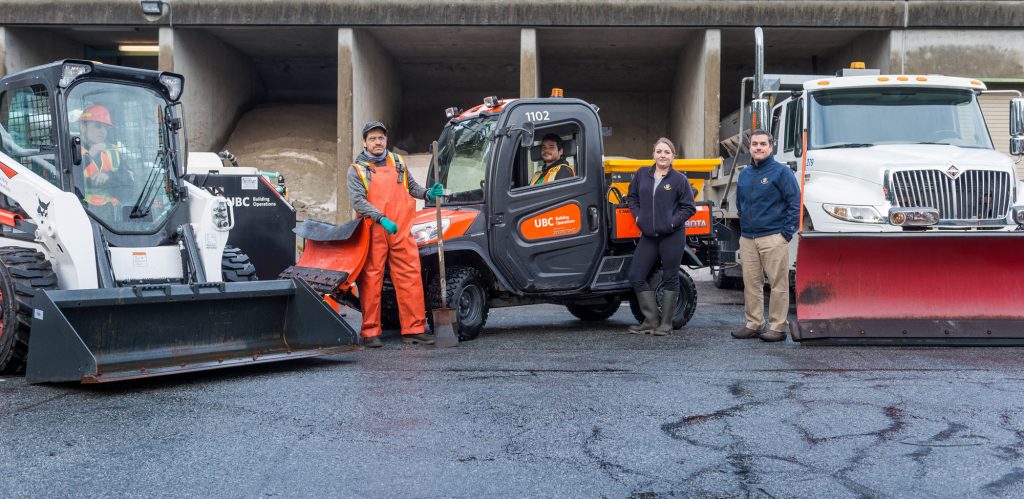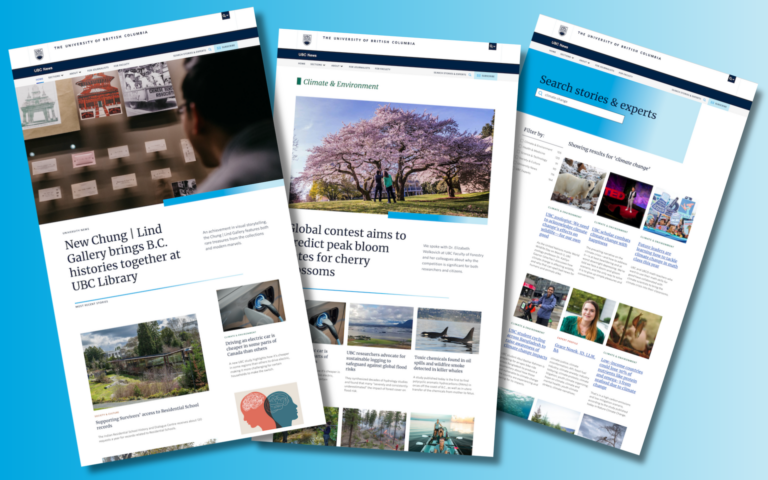UBC campuses ready for snow
On the Vancouver campus, the Building Operations group has equipped its vehicles for winter weather. More than 50 people are working to clear the campus as quickly as possible.
As temperatures drop and expected snowfalls get closer, a team of UBC staff is getting ready to start its snow clearing operations on two campuses.
In fact, staff have been planning for months.
“We really never stop thinking about it,” says Derek Mahoney, Manager of Landscape and Contract Services, in Facilities Management at UBC Okanagan. “We’ve always got winter on our minds.”
Having roads and sidewalks cleared, as well as maintaining open pathways to buildings, doesn’t just keep the university running—it also ensures the safety of faculty, students, staff, and visitors.
“The teams that are focused on snow removal are incredibly dedicated and hardworking, and they always put the campus safety first,” says Mahoney. “They don’t rely upon a call-out to get out of bed at 4:30 in the morning to come and clear the campus—they’re checking it themselves because they can’t sleep. They’re coming to campus early so that people who arrive for normal office hours can get where they need to go safely.”
On the Vancouver campus, the Building Operations group is getting its vehicles equipped for whatever weather is coming. When snow does start falling, approximately 50 people (more if conditions are especially bad) will work to clear the campus as quickly as possible.
A veritable fleet of specially equipped vehicles will be deployed. For sidewalks and pathways there are four mowers with plows, six ATVs with plows and salt spreaders and two ATVS with brine spreaders. For roads there are two dump trucks with plows and spreaders (with another in reserve if required) a pickup with a plow and salt spreader and a flatbed truck with a brine spreader. Two bobcats and two backhoes are there, too, if needed.
UBC has 60 tons of salt, 30 tons of sand and another 30 tons of a salt/sand combination waiting and crews proactively brine to help prevent ice buildup.
“In terms of the decision making process for class cancellations, it’s important to say that these sorts of decisions are never easy,” says Pam Ratner, vice-provost and associate vice-president, Enrolment and Academic Facilities.
“The primary factor we always think about first is student, faculty, and staff safety – this is by far the most important consideration for us. University staff also take into account factors such as current road conditions to campus, municipal road-clearing operations, weather forecasts, our facilities staff’s ability to clear the snow on campus and the transit situation. We are mindful that cancelling classes can create significant disruption for many students, staff and faculty. Ultimately, any decisions around cancellation of classes is made following input from a variety of staff from across the university who can provide specific insight about each of these factors. During significant weather events this team convenes frequently to discuss the evolving situation.”
[big_feature_image src=”http://news.ubc.ca/wp-content/uploads/2018/12/snow1003.jpg” video_id=”U01VFIpIVyQ”][/big_feature_image]
The Building Operations team gets campus-specific weather updates twice a day – a service in place since the infamous winter of 2016-17, which still looms large in the minds of those in charge.
“It was a horrible winter,” says Tamas Weidner, former Manager of the Building Operations Labour Division, who is now responsible for Waste Management and the Garage. “One of the challenges with snow and ice removal is if you have a snowfall that is coming down and doesn’t stop, you can keep plowing the same road over and over and it’ll get covered up.”
It was so bad, recalls Weidner, that when buses stopped coming all the way to campus, he personally drove a truck to pick up members of his team from the bottom of the hill at Alma and Broadway.
Despite the challenges of that year, says Weidner, some good came of it.
“We learned a lot from that winter. We made some changes to how we allocate sidewalks and roads, and the hand-clearing for accessibility, and we noticed huge changes.”



While all of the snow and ice removal used to be managed by the Building Operations Labour Division, it is now a coordinated approach across the Municipal Services branch. The labour group takes on all roads and the clearing of building pathways and accessibility routes on the south side of campus, while the landscape group takes the sidewalks and the pathways on the north side.
Critical to keeping things on track across campus is the UBC garage.
“Any time we need to stay late or start early, we need somebody from the garage to come in as well,” notes Weidner. “When you’re plowing and salting, it’s a lot of force on the equipment. Chains break and hydraulics break constantly. The mechanics play a huge role.”
As intense and stressful as it is, there’s something about everyone pulling together that Weidner can’t help but anticipate with some excitement. “At the end of the day, I think we all kind of look forward to it,” he says. “I know it sounds crazy, but it feels like we’re really making a difference.”
Maps: UBC Point Grey snow removal
Roads and pathways on campus are cleared according to this priority map that ensures important thoroughfares are maintained, and that buildings requiring wheelchair accessibility are clear of obstructions.



